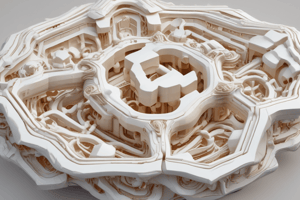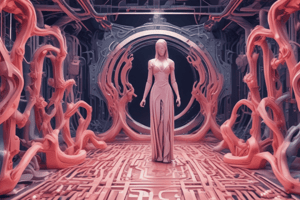Podcast
Questions and Answers
What does AM stand for?
What does AM stand for?
Additive Manufacturing
What is the biggest limitation of AM technology at the moment?
What is the biggest limitation of AM technology at the moment?
The limited range of materials that can be used.
What is the 'functional graded material' used for?
What is the 'functional graded material' used for?
It is used for applications that require materials to withstand high temperatures while maintaining a temperature gradient.
Why is the process of 'robocasting' important for ceramics?
Why is the process of 'robocasting' important for ceramics?
The use of lasers in AM technologies is more expensive than the use of electrons.
The use of lasers in AM technologies is more expensive than the use of electrons.
Which of the following is NOT a common approach to metal part creation in powder bed fusion processes?
Which of the following is NOT a common approach to metal part creation in powder bed fusion processes?
In the SLS process, the powder bed is maintained at an elevated temperature that is just below the melting point.
In the SLS process, the powder bed is maintained at an elevated temperature that is just below the melting point.
In the FDM process, the extrusion head is typically vertically oriented.
In the FDM process, the extrusion head is typically vertically oriented.
Binder jetting is primarily used for the creation of metal parts.
Binder jetting is primarily used for the creation of metal parts.
Which of the following is NOT a common method to improve the surface quality of FDM parts?
Which of the following is NOT a common method to improve the surface quality of FDM parts?
The use of 'whiskers' for reinforcement in AM has been growing in recent years.
The use of 'whiskers' for reinforcement in AM has been growing in recent years.
What is the key process step for ensuring proper bonding and stability for powder bed fusion processes?
What is the key process step for ensuring proper bonding and stability for powder bed fusion processes?
What technology is primarily used in binder printing?
What technology is primarily used in binder printing?
Binder jetting is generally more expensive than laser-based powder bed fusion processes.
Binder jetting is generally more expensive than laser-based powder bed fusion processes.
It refers to the visible layering in FDM printed parts.
It refers to the visible layering in FDM printed parts.
Which of the following is considered a disadvantage of binder printing?
Which of the following is considered a disadvantage of binder printing?
Flashcards
What is Additive Manufacturing (AM)?
What is Additive Manufacturing (AM)?
A manufacturing process that builds objects layer by layer by adding material, as opposed to traditional methods that remove material.
What are the benefits of AM?
What are the benefits of AM?
AM offers numerous advantages, including reduced material waste, increased design freedom, faster prototyping, and on-demand production.
What is a Voxel?
What is a Voxel?
A 3D equivalent of a pixel, representing a single point of material in a 3D model.
What is Rapid Prototyping?
What is Rapid Prototyping?
Signup and view all the flashcards
What is a Digital Twin?
What is a Digital Twin?
Signup and view all the flashcards
What is a Patent?
What is a Patent?
Signup and view all the flashcards
What is Freeform Fabrication?
What is Freeform Fabrication?
Signup and view all the flashcards
What is the difference between 3D Printing and AM?
What is the difference between 3D Printing and AM?
Signup and view all the flashcards
What is the STL file format?
What is the STL file format?
Signup and view all the flashcards
What is a CAD software?
What is a CAD software?
Signup and view all the flashcards
What is a Powder Bed Fusion (PBF) process?
What is a Powder Bed Fusion (PBF) process?
Signup and view all the flashcards
What is Selective Laser Sintering (SLS)?
What is Selective Laser Sintering (SLS)?
Signup and view all the flashcards
What is Selective Laser Melting (SLM)?
What is Selective Laser Melting (SLM)?
Signup and view all the flashcards
What is Electron Beam Melting (EBM)?
What is Electron Beam Melting (EBM)?
Signup and view all the flashcards
What is Vat Polymerization?
What is Vat Polymerization?
Signup and view all the flashcards
What is Stereolithography (SLA)?
What is Stereolithography (SLA)?
Signup and view all the flashcards
What is Digital Light Processing (DLP)?
What is Digital Light Processing (DLP)?
Signup and view all the flashcards
What is Continuous Liquid Interface Production (CLIP)?
What is Continuous Liquid Interface Production (CLIP)?
Signup and view all the flashcards
What is a Photopolymer?
What is a Photopolymer?
Signup and view all the flashcards
What is a Photoinitiator?
What is a Photoinitiator?
Signup and view all the flashcards
What are Support Structures?
What are Support Structures?
Signup and view all the flashcards
What is Post-Processing?
What is Post-Processing?
Signup and view all the flashcards
What is a Melt Pool?
What is a Melt Pool?
Signup and view all the flashcards
What is Balling?
What is Balling?
Signup and view all the flashcards
What is Sputtering?
What is Sputtering?
Signup and view all the flashcards
What is a Functional Graded Material?
What is a Functional Graded Material?
Signup and view all the flashcards
What is Mind Mapping?
What is Mind Mapping?
Signup and view all the flashcards
What is the LCA of a Product?
What is the LCA of a Product?
Signup and view all the flashcards
What is a Disruptive Technology?
What is a Disruptive Technology?
Signup and view all the flashcards
What is a Laser?
What is a Laser?
Signup and view all the flashcards
What is a Galvanometer?
What is a Galvanometer?
Signup and view all the flashcards
What is a CNC Machine?
What is a CNC Machine?
Signup and view all the flashcards
What is an Actuator?
What is an Actuator?
Signup and view all the flashcards
What is a Sensor?
What is a Sensor?
Signup and view all the flashcards
What is the Importance of Material Properties in AM?
What is the Importance of Material Properties in AM?
Signup and view all the flashcards
Why are ceramics used in AM?
Why are ceramics used in AM?
Signup and view all the flashcards
What are Sintering and Full Melting?
What are Sintering and Full Melting?
Signup and view all the flashcards
Why are patents important in AM?
Why are patents important in AM?
Signup and view all the flashcards
Study Notes
Additive Manufacturing Technologies
- Additive manufacturing (AM) is a set of technologies that create objects layer by layer, enabling the creation of complex shapes and structures impossible with traditional manufacturing methods.
- AM has several variations based on the methods used to fuse materials, most significantly the type and form of the raw material.
- AM processes vary in terms of cost, speed, and accuracy, creating different advantages and disadvantages for certain applications.
- AM techniques are connected with creativity and design, with AM promoting innovative design solutions.
- The initial designs are usually in a digital format (CAD) which is used to create the final product
AM Material Classifications
- AM materials are categorized as liquid, particles (powder), molten materials, and sheets/laminates.
- Liquid materials such as photopolymers are used in techniques like stereolithography (SLA).
- Powder materials are used in powder bed fusion (PBF) processes such as selective laser melting (SLM) and selective laser sintering (SLS).
- Molten materials (liquid materials) are used in material extrusion (ME) processes like fused deposition modeling (FDM).
- Sheet materials/laminates are used in sheet lamination processes
Principles of Additive Manufacturing
- AM's principle is to construct an object layer by layer using a digital 3D model for guidance.
- The 3D model is converted into a series of 2D cross-sectional slices or layers.
- Each layer is then built upon the previous one, layering material to create the final form of the object.
- The raw material used in the process can vary across techniques but is always transformed via a specific process into the solid form in the layer.
- Key steps in many types of AM comprise: the use of CAD design software, the transformation (and often refinement) of the data, transfer to the manufacturing device, the printing (layer by layer) and the (sometimes extensive) post-processing steps to remove supports and refine the object for its final application.
Advantages of AM
- Reduced material waste as compared to traditional manufacturing methods.
- Ability to produce complex shapes and geometries.
- Improved design flexibility for rapid prototyping.
- Allows for more creative and innovative designs.
- Potentially lower costs for small batch production or customized products.
- Increased customization options and shorter lead times, particularly relevant for specialized or niche products.
Disadvantages of AM
- Higher initial investment costs for the equipment.
- Limited material selection for certain technologies.
- The potential for greater defects or inconsistencies in the printed object as compared to traditional methods.
- Slower production rates than subtractive methods.
- The potential for issues in repeatability and reproducibility of certain features from print to print.
- Increased requirement for post-processing (e.g., finishing or surface treatment)
AM Process Examples and Specifics
- Several AM processes use various methods to build the product, such as melting, sintering, deposition, or curing.
- Stereolithography (SLA), Fused Deposition Modeling (FDM), Selective Laser Sintering (SLS), and Selective Laser Melting (SLM) are all common examples.
- Each technology (e.g., SLA) comes with its own constraints and specifications regarding the types of materials usable.
Studying That Suits You
Use AI to generate personalized quizzes and flashcards to suit your learning preferences.




